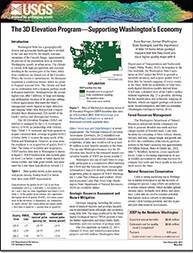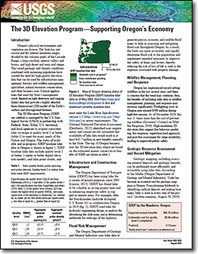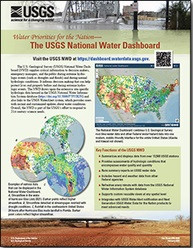
Product Details
- Product Number
- 534313
- Series
- FS-2022-3075
- Scale
- NO SCALE
- Alternate ID
- FS-2022-3075
- Authors
- TOM CARLSON
- Version Date
- 05/01/2023
- Countries
- USA
- Media
- WEB ONLY
- Format
- WEB ONLY
Additional Details
- Description
-
The 3D Elevation Program—Supporting Washington’s Economy
Fact Sheet 2022-3075
National Geospatial Program
By: Tom Carlson
https://doi.org/10.3133/fs20223075
This product is not available for order, it can only be downloaded from here or within the Publications Warehouse at https://pubs.usgs.gov/publication/fs20223075
For additional information, contact:
Director, National Geospatial Program
https://www.usgs.gov/programs/national-geospatial-program
U.S. Geological Survey
12201 Sunrise Valley Drive, Mail Stop 511
Reston, VA 20192
Email: 3DEP@usgs.gov
Introduction
Washington State has a geographically diverse and spectacular landscape that is divided to the east and west by the largely volcanic mountains of the Cascade Range. Approximately 88 percent of the population lives in western Washington, mostly in urban areas. The climate is varied, with high precipitation and seasonal flooding in the western part of the State, while drier conditions are found east of the Cascades. Where the terrain is mountainous, the dominant vegetation is coniferous forests, which are prone to frequent seasonal fires. The climate and land use in combination with a dynamic geology result in frequent landslides. Washington has the second highest risk, after California, of large and damaging earthquakes because of its geologic setting. Critical applications that meet the State’s management needs depend on light detection and ranging (lidar) data that provide a highly detailed three-dimensional (3D) model of the Earth’s surface and aboveground features.
- Survey Date
- 2022
- Print Date
- 2022
- Height In Inches
- 11.000
- Length In Inches
- 8.500
- Languages
- English





